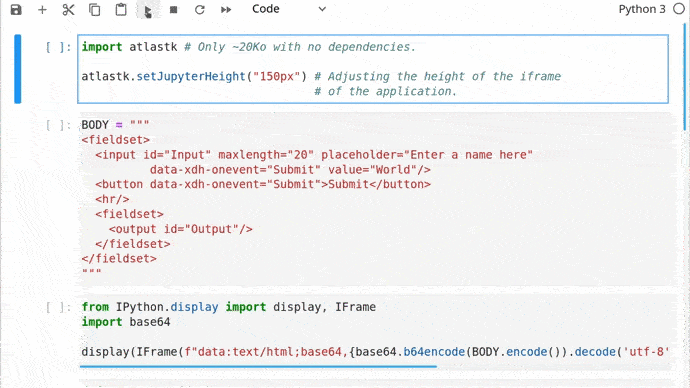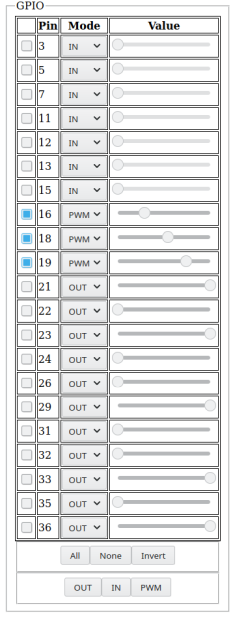# *Python* version of the *Atlas* toolkit
[](https://q37.info/s/vwpsw73v) [](https://q37.info/s/sssznrb4)
[](http://github.com/epeios-q37/atlas-python/)
[](https://github.com/epeios-q37/atlas-python/blob/master/LICENSE)
[](https://atlastk.org)
[](http://q37.info/s/9srmskcm)
<!--
Si la table ci-dessous est modifiée, alors modifier également (pages du site atlastk.org) :
- la page '_index' ;
- la page 'Online demonstrations' ;
-->
> The [*Atlas* toolkit](https://atlastk.org) is available for:
> | Language / Demo | Repositories | Popularity |
> |:-:|:-:|:-:|
> | [](https://q37.info/s/qtnkp9w4)<br/>[](https://q37.info/s/3vwk3h3n) | [](https://framagit.org/epeios-q37/atlas-java) [](https://github.com/epeios-q37/atlas-java)<br/>[](https://gitlab.com/epeios-q37/atlas-java) | [](https://github.com/epeios-q37/atlas-java/stargazers)<br/>[](https://github.com/epeios-q37/atlas-java/network/) |
> | [](https://q37.info/s/3d7hr733)<br/>[](https://q37.info/s/st7gccd4) | [](https://framagit.org/epeios-q37/atlas-node) [](https://github.com/epeios-q37/atlas-node)<br/>[](https://gitlab.com/epeios-q37/atlas-node) | [](https://github.com/epeios-q37/atlas-node/stargazers)<br/>[](https://github.com/epeios-q37/atlas-node/network/) |
> | [](https://q37.info/s/4nvmwjgg)<br/>[](https://q37.info/s/h3h34zgq) | [](https://framagit.org/epeios-q37/atlas-perl) [](https://github.com/epeios-q37/atlas-perl)<br/>[](https://gitlab.com/epeios-q37/atlas-perl) | [](https://github.com/epeios-q37/atlas-perl/stargazers)<br/>[](https://github.com/epeios-q37/atlas-perl/network/) |
> | [](https://q37.info/s/pd7j9k4r)<br/>[](https://q37.info/s/vwpsw73v) | [](https://framagit.org/epeios-q37/atlas-python) [](https://github.com/epeios-q37/atlas-python)<br/>[](https://gitlab.com/epeios-q37/atlas-python) | [](https://github.com/epeios-q37/atlas-python/stargazers)<br/>[](https://github.com/epeios-q37/atlas-python/network/) |
> | [](https://q37.info/s/gkfj3zpz)<br/>[](https://q37.info/s/9thdtmjg) | [](https://framagit.org/epeios-q37/atlas-ruby) [](https://github.com/epeios-q37/atlas-ruby)<br/>[](https://gitlab.com/epeios-q37/atlas-ruby) | [](https://github.com/epeios-q37/atlas-ruby/stargazers)<br/>[](https://github.com/epeios-q37/atlas-ruby/network/) |
<ins>***WebGPIO* (*Raspberry Pi*/*ODROID-C2*)**</ins>: the *WebGPIO* application, with which you can control the *Raspberry Pi*/*ODROID-C2* (and probably other similar devices) GPIOs with your smartphone, is described in the *Raspberry Pi*/*ODROID-C2* below section.
---
## A GUI with *Python* in a couple of minutes
Click the animation to see a screencast of programming this ["Hello, World!" program](https://en.wikipedia.org/wiki/%22Hello,_World!%22_program) with *Python* in a matter of minutes:
[](https://q37.info/s/rt9wr4w3)
Same video on [*Peertube*](https://en.wikipedia.org/wiki/PeerTube): <https://q37.info/s/qfcng9j4>.
Source code:
```python
import atlastk
BODY = """
<fieldset>
<input id="Input" xdh:onevent="Submit" value="World"/>
<button xdh:onevent="Submit">Hello</button>
<hr/>
<fieldset>
<output id="Output">Greetings displayed here!</output>
</fieldset>
</fieldset>
"""
def acConnect(dom):
dom.inner("", BODY)
dom.focus("Input")
def acSubmit(dom):
name = dom.getValue("Input")
dom.begin("Output", f"<div>Hello, {name}!</div>")
dom.setValue("Input", "")
dom.focus("Input")
CALLBACKS = {
"": acConnect,
"Submit": acSubmit
}
atlastk.launch(CALLBACKS)
```
### See for yourself right now - it's quick and easy!
#### Online, with nothing to install
To run above "Hello, World!" program directly in your browser, as seen in corresponding video, follow this link: <https://replit.com/@AtlasTK/hello-python>.
Thanks to [*Replit*](https://q37.info/s/mxmgq3qm), an [online IDE](https://q37.info/s/zzkzbdw7), you can write and run programs using the *Atlas* toolkit directly in your web browser, without having to install *Python* on your computer [](https://q37.info/s/sssznrb4).
To see more examples, like the following [*TodoMVC*](http://todomvc.com/), simply:
- go [here](https://q37.info/s/vwpsw73v) (also accessible with the [](https://q37.info/s/vwpsw73v) button at the top of this page),
- click on the green `run` button,
- choose the demonstration to launch,
- open the then displayed URL in a browser (should be clickable),
- … and, as you wish, run your own tests directly in your browser, by modifying the code of the examples or by writing your own code.
[](https://q37.info/s/vwpsw73v)
#### With *Python* on your computer
```shell
# You can replace 'github.com' with 'framagit.org' or 'gitlab.com'.
# DON'T copy/paste this and above line!
git clone http://github.com/epeios-q37/atlas-python
cd atlas-python/examples
python Hello/
```
## *Android* devices
Programs made with the *Atlas* toolkit work perfectly on your [*Android*](https://en.wikipedia.org/wiki/Android_(operating_system)) devices (smartphone or tablet) using the [*Termux*](https://termux.com/) application. Simply install (``pkg intall …``) the *git* and *python* packages. That's all!
## *Jupyter* notebooks
When using the *Atlas* toolkit in a [*Jupyter* notebook](https://en.wikipedia.org/wiki/Project_Jupyter#Jupyter_Notebook), the GUI is embedded in the notebook, as shown here:

*Jupyter* notebook examples can be found in the *tutorials* directory.
## Your turn
If you want to take your code to the next level, from [CLI](https://q37.info/s/cnh9nrw9) to [GUI](https://q37.info/s/hw9n3pjs), then you found the right toolkit.
With the [*Atlas* toolkit](http://atlastk.org/), you transform your programs in modern web applications ([*SPA*](https://q37.info/s/7sbmxd3j)) without the usual hassles:
- no *JavaScript* to write; only *HTML*(/*CSS*) and *Python*,
- no [front and back end architecture](https://q37.info/s/px7hhztd) to bother with,
- no [web server](https://q37.info/s/n3hpwsht) (*Apache*, *Nginx*…) to install,
- no need to deploy your application on a remote server,
- no incoming port to open on your internet box or routeur.
The *Atlas* toolkit is written in pure *Python*, with no native code and no dependencies, allowing the *Atlas* toolkit to be used on all environments where *Python* is available.
And simply by running them on a local computer connected to internet, applications using the *Atlas* toolkit will be accessible from the entire internet on laptops, smartphones, tablets…
The *Atlas* toolkit is particularly well suited for educational purposes, to write modern programming exercises, i.e. with a true graphical interface instead of the usual outdated textual one. More about this can be found [here](https://q37.info/s/cbms43s9).
*Python* is much more powerful then *Excel* macros to automate (boring) tasks, and you can also work with *PDF*, *Word*, *Google* files…. And with the *Atlas* toolkit, you have much more possibilities then with *VBA* forms. There are some examples [here](https://q37.info/s/97p44nh4).
There is also a stub to for this library at address <https://q37.info/s/zzcn3wnx>.
> You will also find programs from [*The Big Book of Small Python Projects*](https://inventwithpython.com/bigbookpython/) by [Al Sweigart](http://alsweigart.com) to which a graphical user interface using the *Atlas* toolkit were added in this repository: [epeios-q37/AlSweigartTheBigBookPython](https://q37.info/s/kd3bwchj).
## Content of the repository
The `atlastk` directory contains the *Python* source code of the *Atlas* toolkit, which is the directory you have to reference in `PYTHONPATH` in order to use the *Atlas* toolkit in your own program, unless you have installed the [*atlastk* package](http://q37.info/s/9srmskcm) with `pip install atlastk`.
In the `examples` directory, you will found following examples:
- `Blank`: very basic example,
- `Hello`: ["*Hello, World!*"](https://en.wikipedia.org/wiki/%22Hello,_World!%22_program),
- `Chatroom`: multi-user chatroom,
- `Notes`: note taking program,
- `TodoMVC`: [*TodoMVC*](http://todomvc.com/),
- `Hangman`: [Hangman game](http://q37.info/s/gtdtk4hp),
- `15-puzzle`: [15-puzzle game](https://q37.info/s/jn9zg3bn),
- `Contacts`: a basic address book,
- `Widgets`: some widgets handled with the *Atlas* toolkit,
- `Chatrooms` : same as above `Chatroom`, but with several rooms,
- `PigGame`: [Pig game](https://en.wikipedia.org/wiki/Pig_(dice_game)) for one or two players,
- `Reversi`: [*Reversi* game](http://q37.info/s/zz3dzmf7) for one or two players,
- `MatPlotLib` : the *Atlas* toolkit displaying some graphics made with [*matplotlib*](https://matplotlib.org/); this example needs, of course, the *matplotlib* package to be installed…
Other examples are detailed in the next section.
Except for the *ErgoJr*, *GPIO* and *RGB* applications, which are detailed in the next section, to run an example, launch, from within the repository, `python main.py`, and select the example you want to run.
You can also directly launch, from within the `examples` directory, `python <Name>/` (don't forget the final `/`), where `<Name>` is the name of the example (`Blank`, `Chatroom`…).
The *Stars* application is an example where the *Atlas* *toolkit* is used to control a [*Pygame*](https://en.wikipedia.org/wiki/Pygame) based application. Of course, *Pygame* needs to be installed.
The `tutorials` directory contains some [*Jupyter* notebooks](https://en.wikipedia.org/wiki/Project_Jupyter#Jupyter_Notebook) about the *Atlas* *toolkit*.
## *Raspberry Pi*/*ODROID-C2*
**If the applications does not work on your *Raspberry Pi*, please see this issue: <https://github.com/epeios-q37/atlas-python/issues/1>**
The *GPIO* and *RGB* applications are designed to be used on a *Raspberry Pi* or a *ODROID-C2*.
Here is how the *WebGPIO* application looks like:

For the *Raspberry Pi*, the `RPi.GPIO` *Python* module have to be installed (this is probably already the case).
For the *ODROID-C2*, The *Python* version of *WiringPi* must be installed, and the application has to be launched, from within the `examples` directory, with `sudo` (`sudo python GPIO/` or `sudo python RGB/`).
The *ErgoJr* application is experimental and to control a *Poppy* *Ergo Jr* robot.
The *RGB* application is dedicated to the control of a RGB led, and the *GPIO* (aka *WebGPIO*) application allows to control the basic pins. Click below picture to see a *YouTube* video on how they work (same video on [*PeerTube*](https://en.wikipedia.org/wiki/PeerTube): <https://q37.info/s/49pbmwv9>):
[](https://www.youtube.com/watch?v=C4p2iX6gc-Q)




